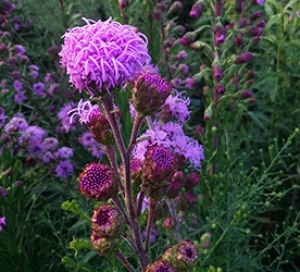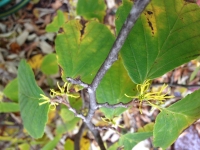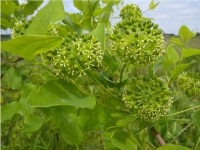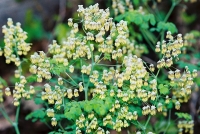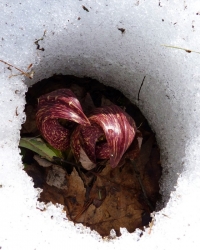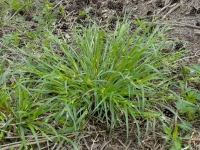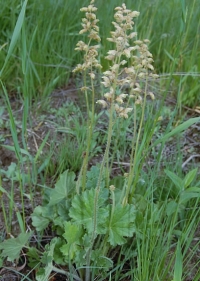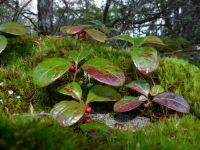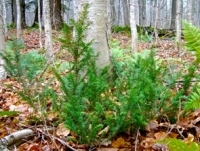
Native Plants to Know: Meadow Blazing Star
When it comes to attracting monarch butterflies for nectaring, meadow blazing star (Liatris ligulistylus) wins hands down! This patch had 15 monarchs on it before I got close to take a picture.
Meadow blazing star will grow in seasonally damp, medium, or slightly dry sites but it prefers loam to sandy loam soil with a good amount of organic material (not a fan of heavy clay). While it does best in full sun this is one of the better blazing stars for yards with partial shade.
Native Plant Spotlight: American Witch-hazel (Hamamelis virginiana)
What an odd name… witch-hazel. What does it mean? Well, some folks think the leaves look similar to the hazelnut shrub’s leaves, hence the “hazel” portion of the name. But, why “witch”? There are several possibilities. The pliable branches of the witch-hazel have been used as divining rods to search for water, also called water witching. Or it could be for the Old English “wych” which means pliable, as in the English wych elm with its bendable branches. My favorite explanation is this: When witch-hazel seeds mature in the fall they explode out of the fruit in distances of up to 25 feet away! When people would walk through the woods in the fall, they would be startled by the sound of the recently exploded witch-hazel seeds hitting the ground or the leaves of nearby bushes, so they started calling those shrubs “witch hazels” (soucrce: Bedford Audubon Society).
Native Plant Spotlight: Carrion-flower
In this native plant highlight, we are going to look at the carrion-flower (Smilax herbacea), a member of the Smilacaceae family. Plants in this family are shrubs, herbs, or vines and usually perennial. The Smilacaceae family is found in tropical to sub-tropical environments, so you can think of the Carrion-flower as a piece of paradise in Southeast Wisconsin!
Native Plant: Early Meadow-Rue
The buttercup family (ranunculacea) has 1,700 species distributed around the world with about 70 occuring in Wisconsin. Some of the more familiar species include wild columbine (Aquilegia canadensis), virgin's bower (Clematis virginiana), marsh marigold (Caltha palustris), and American pasque flower (Anemone patens L. var. multifida). Early meadowrue (Thalictrum dioicum) is one member of the family blooming in the woods this time of year. With graceful grayish-green fern-like foliage, and dainty, tassel-like flowers, this one is worth finding on a spring walk.
Native Plant: Eastern Skunk Cabbage
What native Wisconsin plant is the first to bloom in the spring, generates its own heat capable of thawing frozen soil and melting snow, and produces flowers before leaves; flowers that emit a smell of rotting flesh?
Skunk cabbage!
Not a true cabbage, skunk cabbage is a member of a mostly tropical family of plants, the Arum family or Araceae. Other well known members of the Arum family include calla lilies, philodendrons, taros (elephant ears), as well as other native plants like Green Dragon and Jack-in-the-pulpit. Skunk cabbage gets its name from the pungent skunk-like odor released when any part of the plant is broken or damaged and from its large leaves which grow in a rosette somewhat like a cabbage.
Native Plant: Common Wood Sedge
Common Wood Sedge, Carex blanda, is one of the most ubiquitous native woodland plants. This lush yet tough plant is often seen growing next to paths indicating that it is well adapted to disturbed and compacted soils and that its seeds are spread via mud stuck to the bottom of shoes, paws, and hooves. The seeds may also be distributed by woodland ants. The leaves and seeds of native Carex are an important sources of food for wildlife.
Native Plant: Prairie Alum Root
This month's native plant is Prairie Alumroot, Heuchera richardsonii. There are about fifty species of Heuchera distributed throughout North America. Heuchera are comonly called Coral Bells or Alumroot and a wide variety of hybrids and cultivars have been bred and selected with colorful or variegated leaves. Prairie alumroot is the only Heuchera native to Wisconsin. A member of the saxifrage family (Saxifragaceae), some of its cousins include genera such as Ribes (gooseberry and current), Astilbe (false spirea), and Tiarella (foamflower).
Native Plant of the Month - Wintergreen
The famous biologist and philosopher E.O. Wilson coined the word biophilia to describe the instinctive human bond between humans and other living systems. One way human biophilia is expressed this time of year is in the placement of evergreen boughs, wreaths, and trees in homes and public spaces. Before the invention of plastic foliage and even before the first Christmas, evergreens were celebrated as symbols of eternal life and incorporated in celebrations across North Africa, Europe, and Northern Asia. And before the word 'evergreen' was first used to refer to plants that keep their leaves year-round, English speakers referred to them as 'wintergreen'. Today the meaning of the word 'wintergreen' has narrowed and refers exclusively to broadleaved plants in the genus Gaultheria.
Native Plant of the Month: Frost Aster
The frost aster is a member of the composite family. Composites are unique in that their "flowers" are actually many flowers packed together in a compound flowerhead. These small flowers are referred to as florets. In the center of the flowerhead are the disc florets which are fertile (produce seeds).
Native Plant of the Month: Canada Yew
The Yew Family: Yews are in the family Taxaceae which is in the order Pinales. The Pinales include all living genera of conifer such as pine, juniper, fir, and spruce etc. Yews have a highly specialized cone in which a modified scale wraps around a single seed and forms a fleshy fruit called an aril that looks like a berry.
Copyright © 2023 The Urban Ecology Center

